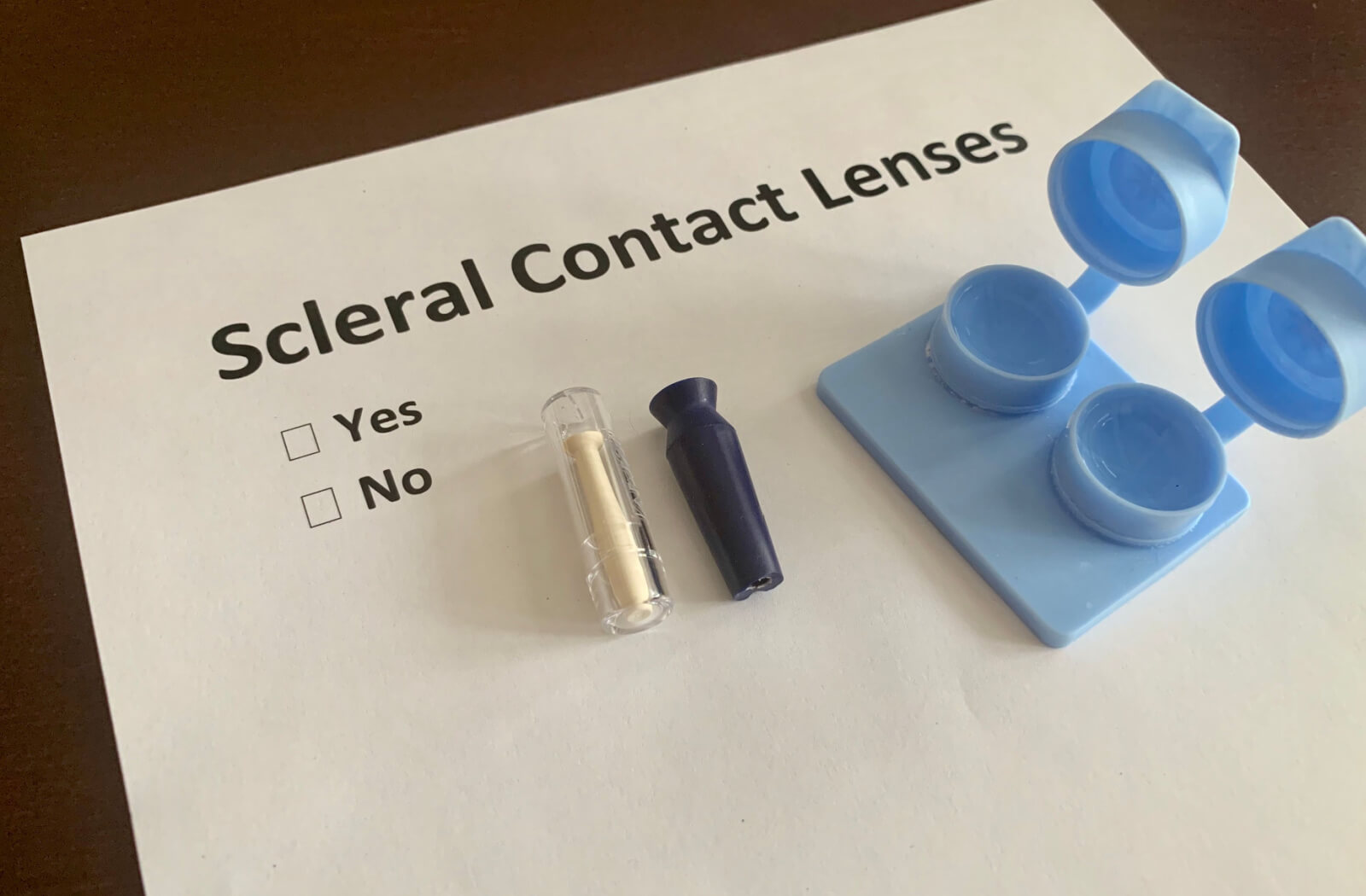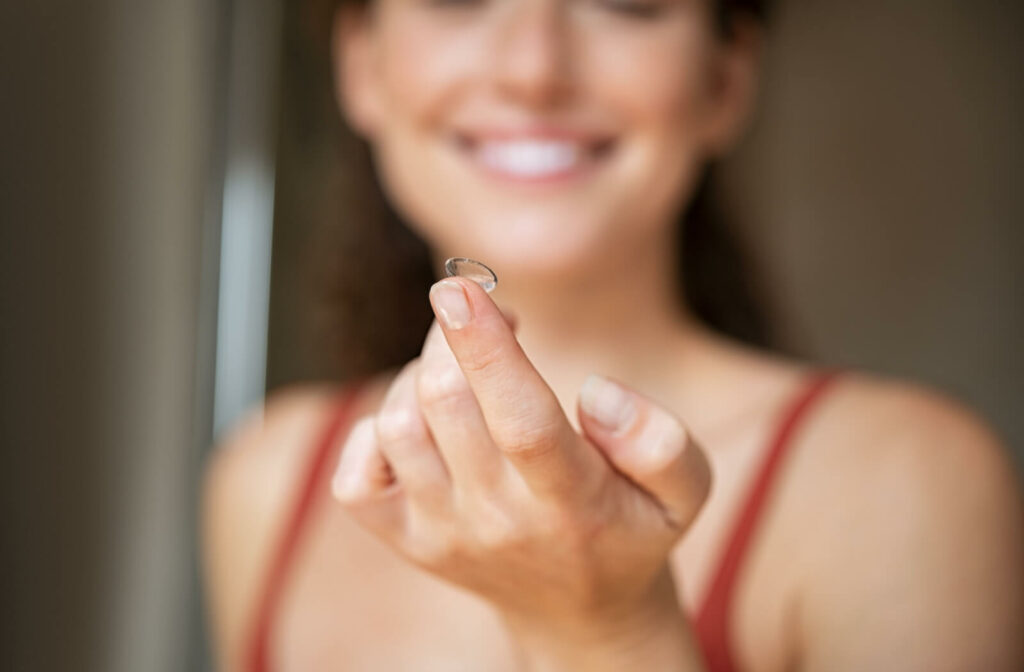We’ve come a long way with contact lens technology. There was a time when some people couldn’t enjoy the benefits of clear vision without eyeglasses, but now we have lenses designed specifically for even the most unique eyes. One lens type popular for those with dry eyes or astigmatism are scleral lenses. But when you’re investing in your vision, you probably want to know how far that investment goes.
Scleral are rigid gas-permeable (RGP) lenses, meaning they’re more durable than soft contacts and can last 1–3 years, depending on how you care for them.
What are Scleral Lenses?
Scleral lenses are a type of rigid gas-permeable (RGP) contact lens. Unlike conventional contact lenses that rest on the cornea, scleral lenses vault the cornea entirely, resting on the white of the eye, or sclera. They’re bigger and, for some people, they may be better. The fact they don’t touch the cornea offers a whole new world for those barred from the joys of lens wear due to astigmatism, keratoconus, or other corneal irregularities. But that’s just the beginning.
This “vaulting” leaves a nice space between the lens and the eye, which you can fill with saline to create a refreshing moisture reservoir. This hydration remains in place as long as you wear the lenses, helping keep discomfort at bay and offering relief for those with severe dry eye.
Benefits of Scleral Lenses
Scleral lenses’ larger size and moisture reservoirs come together to offer many benefits for their wearers when compared to soft contact lenses. Some of the main benefits of scleral lenses include:
- Improved stability & comfort: Scleral lenses’ size makes them more stable on the eye. When your lens isn’t slipping around, it tends to be more comfortable too. Although RGP lenses typically take longer to grow accustomed to than soft contacts, many wearers say scleral lenses are more comfortable.
- Sharper vision: As an RGP lens, scleral lenses’ harder surface provides sharper, more consistent vision correction than alternatives.
- Additional eye protection: Consider scleral lenses as a shield for your eyes! They can form a seal on the sclera, keeping out dust, dirt, and other environmental irritants.
What Affects Contact Lens Lifespan?
Rigid contact lenses don’t “go bad” like an apple you forgot in the fridge. But they still have a lifespan. Contact lenses are medical devices and need to stay sterile so they don’t damage your eyes. If you’ve ever worn soft contact lenses, you know they come in blister packs of saline solution. This helps keep them clean until you wear them. However, these are typically thrown out soon after.
On the other hand, scleral lenses, and most RGP lenses, are in it for the long haul. The materials used in your contact lenses play a monumental role in their longevity. RGP lens material is more resistant to build-up since you’ll likely wear the same pair for much longer than soft lenses.
This means scleral lenses require more attention. Like any good mechanic will tell you, regular care and fine-tuning are the keys to machine longevity. Contact lenses are very simple machines, but they’re susceptible to bacteria that can cause severe eye infections.
Taking care of scleral lenses means daily cleaning, appropriate storage, and using the recommended solution to avoid build-up that not only clouds your vision but also weakens the lens integrity.
And, of course, some lenses don’t last simply because your vision changed. Fortunately, this problem is easily solved. Your optometrist can update your prescription and get you a new pair of lenses with an eye exam and contact lens fitting.
If your vision doesn’t change a well-kept pair of RGP scleral lenses could last up to 3 years!

Tips for Prolonging Your Scleral Lenses’ Lifespan
Now that you know what dictates your lens’s lifeline, it’s time to play offense. Which, ironically, is by playing defense against bacteria and damage. You always want to make sure you’re cleaning and storing your lenses properly, and your optometrist can take you through the instructions for your specific brand.
Here are some simple steps to maintain contact lenses:
- Begin with a clean slate: Wash your hands thoroughly with a mild soap and dry them with a lint-free towel. Consider this step starting your routine with the ultimate hygiene high-five!
- Rub gently: Place your scleral lens in the palm of your hand and apply a few drops of specially formulated cleaning solution. Use a soft, circular motion with your fingertip to cleanse each side.
- Rinse and revel: Rinse the lenses using a saline or prescribed rinse solution. This should wash away all the tiny impurities.
- Put your contacts to bed: Time to tuck them in! Fill your clean, dry lens case with fresh solution. It’s important to always replace the solution each time you store them—don’t simply top it off!
The solution you use to clean and disinfect your lenses is the most important part. Some systems use multipurpose solutions while others are hydrogen peroxide based. If you’re ever unsure what to use, contact your optometrist and ask for help.
And please don’t use saliva to wet your lenses. You may be surprised to learn your mouth isn’t sterile.
With this routine, your scleral lenses can be ready to help you conquer another day with clarity!
Enjoy the Benefits of Contacts with Fontana
Scleral lenses bring the comfort and style of contacts to groups that previously were left out. So while they’re gifting you with sharper vision, protect them with proper care.
Fontana Optometric Group can offer advice to help your lenses last. So if you’re curious if scleral lenses can relieve your dry eye or give clear sight with astigmatism, we’re just a click away. Book your appointment today!


